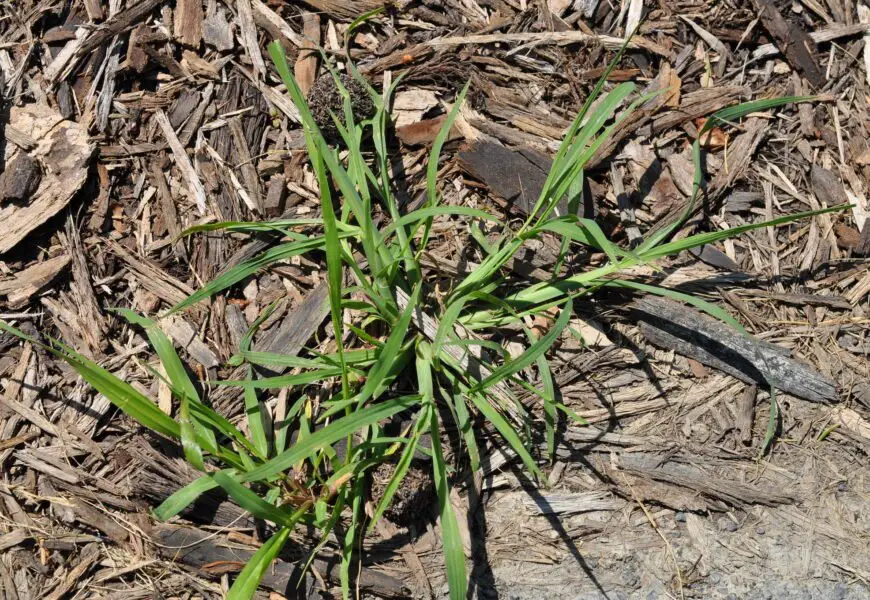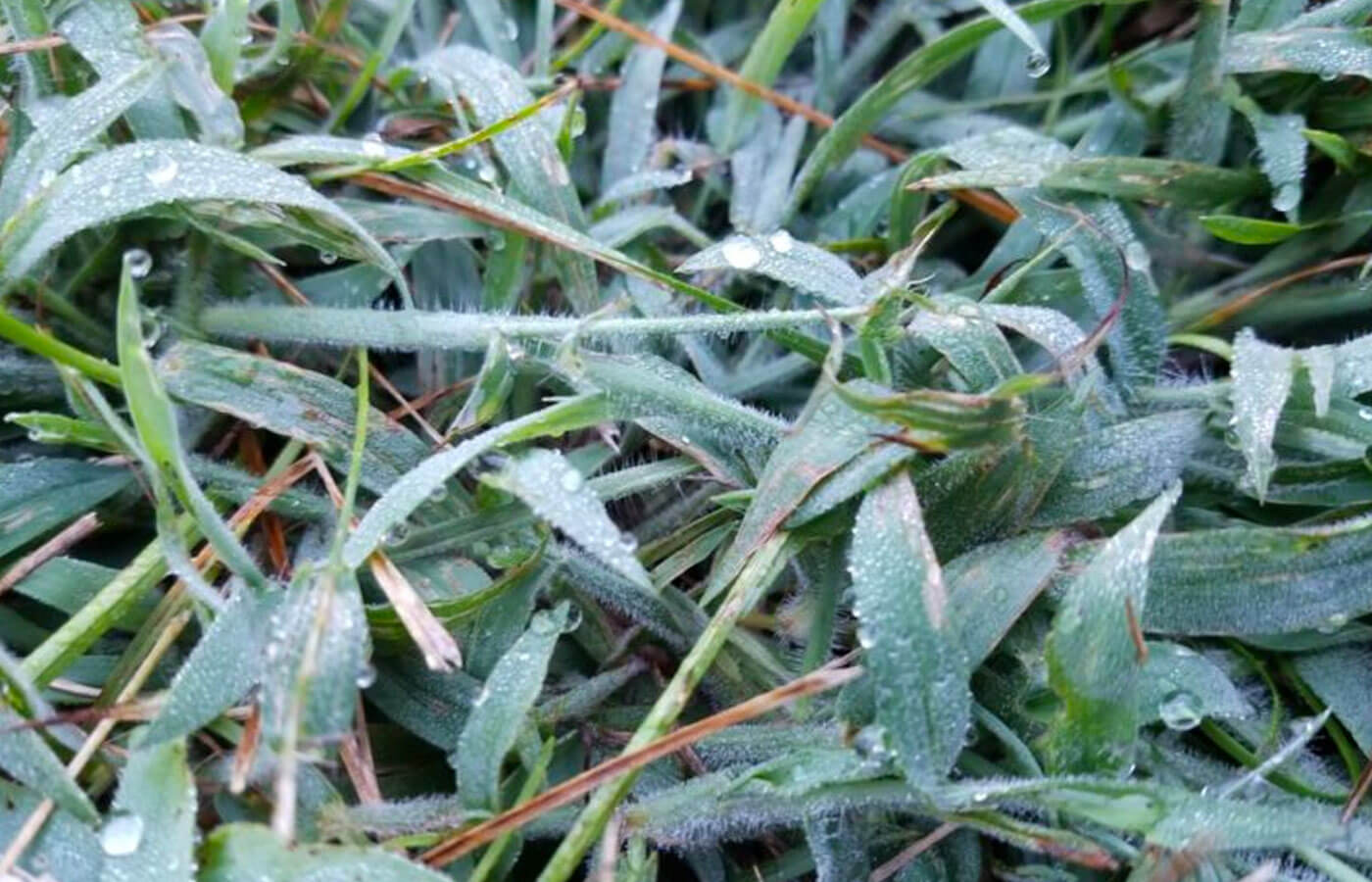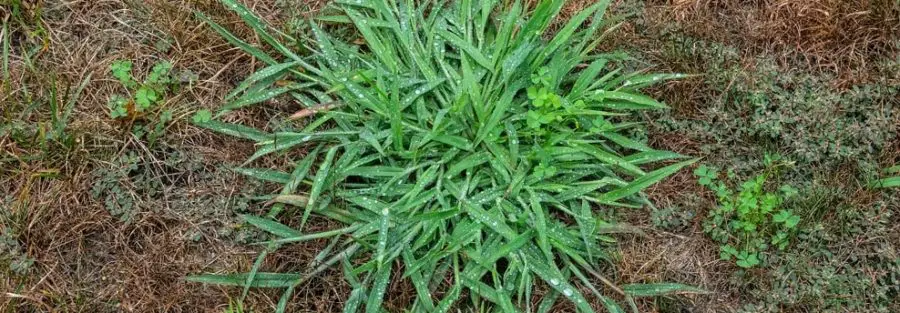Fight Crabgrass With A Healthy Lawn
Fight crabgrass most effectively by shading it out with a thick, healthy lawn. A thick lawn provides a dark canopy of grass blades over the seeds, so they wont sprout.
Thoroughly water your lawn once a week to encourage the grasss root system to go deeper, making the whole lawn more hardy and heat tolerant. Avoid short, frequent waterings. These sips will promote a shallow, weaker root system in your lawn.
Keep your lawn mowed to a height of 2 to 3 inches. Mowing it shorter than 2 inches will reduce the grasss vitality and give weeds a chance to move in. Be sure to keep your lawn mower blades sharp so they wont tear the grass. Leave grass clippings on the lawn as a natural fertilizer.
Reduce compaction. Weeds thrive in areas where compacted soil deprives the grass roots of the air and water circulation they need. If your yard is prone to compaction, rent and run an aerator over it every other year, especially if your soil contains a lot of clay.
Avoid lawn fertilizers that say quick green-up on the label. These have excessive nitrogen ingredients that will actually weaken your lawn over time, making it more susceptible to weeds. Instead, select a fertilizer product with half of its nitrogen in a slow-release form. For a 1,000-sq.-ft. lawn, use less than 3 lbs. of nitrogen annually.
Reseed as needed. Weed-damaged or thin areas should be seeded in the fall, when the days are warm, the nights are cool and you have dew in the mornings.
Can I Treat Crabgrass In The Summer
You can still treat crabgrass in summer but it is not a very good idea. This is because by the time you get to summertime, crabgrass seeds are beginning to germinate and it will be harder to get rid of the many colonies.
The most opportune time to treat the crabgrass on your lawn is in the spring. Around this time, the weed has not produced any seeds yet. This way, you are sure that after you get rid of the crabgrass weed, it will not return since there are no germinating seeds on your lawn.
But for any reason you did not get rid of the weed in spring, use a post-emergent herbicide and pre-emergent herbicide during the summer. Pre-emergent herbicide prevents the seeds from germinating in spring.
Herbicides Might Be A Remedy But Not The Solution
Remember the common saying treat the disease, not the symptom, which is the epitome of good health care? The same applies to lawns stricken with crabgrass.
Crabgrass invades thin lawns, cut too low, underwatered, under-fertilized, and poorly drained. Essentially whenever there is a poorly maintained lawn, crabgrass will eventually start to take over.
Therefore, using weed killers is not a final solution to the problem. As long as the conditions are not right, it will keep returning. Its a bit like trying to treat a broken arm with painkillers.
Dont Miss: How To Control Moles In Your Lawn
You May Like: Clean Outdoor Plastic Furniture
Killing Lawn Weeds In The Fall
Its also important to note, if you’regetting rid of crabgrass in fall, it could interfere with aeration and overseeding, which should also take place in the fall. If you treat the lawn with post-emergent weed control, its also going to kill your newly germinating lawn if you dont wait a week or more.
The best option would be to apply weed control products in early fall, then wait a week or more to perform an aeration and overseeding. This will get rid of the majority of your weeds and allow the new grass plants enough time to germinate before winter comes. Next spring you will be able to apply pre-emergent crabgrass control and treat broadleaf weeds as normal, to keep them from invading your newly-improved lawn.
What Can You Do If You Have Crabgrass

Unfortunately, there isnt much you can do about Crabgrass, once you get it. The best solution is to thicken your lawn later in the Summer by seeding to help prevent Crabgrass from returning the next year. Below are a few other suggestions.
HAND PULLINGIf it is manageable, one option is to pull Crabgrass out by hand, or with a weed pulling tool, such as the Weed Out, which is perfect for remove this Crabgrass. If your lawn has a lot of Crabgrass, you may need to live with it this year, but work toward preventing it next year.
SPOT CHEMICAL SPRAYThere are chemicals that sometimes work to kill Crabgrass. However, they’re not completely effective. If the Crabgrass is already big and ugly, the chemicals will just turn it purple and more unattractive. Your best bet is to let Mother Nature take her course and kill it with cold weather.
THICKEN YOUR LAWN & MINIMIZE BARE PATCHESA thick, healthy lawn is the best defense against Crabgrass. Seeding in the late Summer will add tougher, modern grasses that compete well with Crabgrass. Slice Seeding is great if the problem is throughout your lawn. If it’s just patches, rough up the dirt and seed in the Fall and/or Spring.
USE GOOD NATURE FERTILIZERSThe fertilizers in our Organic Foundation Lawn Care Program help to increase your lawns resistance to issues, such as Crabgrass. Our program works to continuously strengthen your lawn over time, so the longer you use our fertilizers, the more weed-resistant your lawn will become.
MOWING HEIGHT
Read Also: Trugreen Service Plans
How To Kill Crabgrass And Prevent It From Returning
Once crabgrass gets started in your lawn, those coarse, unattractive weeds seem to live and spread forever. But unlike lawn weeds that do live several years, crabgrass plants only live a single year. What they do in that year, however, has long-lasting consequences for your lawn. Understanding how crabgrass works and how to break its cycle can help you get rid of crabgrass and keep it gone.
When To Apply Crabgrass Preventers In Spring
If you are a homeowner with a lawn to tend to, at some point you have probably wondered, When should you apply crabgrass preventers in spring?
This common lawn weed generally appears in late May in the North , so earlier in the spring is the time for applying crabgrass killers if you want to get the jump on your nemesis. You will want to use pre-emergent herbicides, specifically. These products are also termed crabgrass preventers, because they do just that . Corn gluten is considered an organic alternative to using chemical pre-emergent herbicides.
But since getting the timing right is so critical to success in controlling this weed, we will have to be more precise about when to apply a crabgrass preventer.
Also Check: First Zero Turn Lawn Mower
I Missed Putting Down My Pre
If you happen to miss the window for applying a pre-emergent herbicide you still have options. Post-emergent herbicides like quinclorac and mesotrione can be effective, but you need to apply them while plants are still young. The longer you wait, the less effective they will become.
Hand pulling crabgrass plants is also an option, but can be time-consuming and potentially labor-intensive.
One of the best strategies to combat crabgrass, and other weeds in general, is to maintain a healthy lawn. A thick, healthy lawn has a robust root system with lots of aboveground growth to outcompete many lawn weeds.
To learn more, please visit these other resources available from the University of Minnesota.
Crabgrass Takes Over The Lawn
Crabgrass grows even in the worst conditions because it is remarkably stubborn and self-sufficient. It can steal valuable nutrients and moisture from your lawn, making it difficult for other grasses to grow. As a weed that germinates in the spring and dies off in the fall, crabgrass is also known for having a higher stalk space that creates a perfect haven for pests.
Related: Identifying Crabgrass and Other Common Weeds in Lagrangeville, NY
Read Also: Hydro Mousse Liquid Lawn Menards
How To Get Rid Of Crabgrass Without Chemicals
Crabgrass dies on its own each year in fall. If you can wait it out, the weed will be gone by winter, and crabgrass wont return if you apply a pre-emergent next spring.
Or you can pull out small crabgrass infestations by hand. Then, follow it up with healthy lawn care habits to lessen its chances of returning.
Apply The Natural Pre
The role of a pre-emergent agent is to stop any seeds from germinating. Since crabgrass produces so many seeds and since that is the main tactic it uses to spread around, applying the pre-emergent over your grass in the spring is well worth it.
Corn gluten is a great organic pre-emergent that will hinder crabgrass seed germination. Also, as it degrades, it releases nitrogen that feeds your already established turf.
Apply 20 pounds of corn gluten for every 1,000 square feet of your lawn.
Recommended Reading: How Much Does It Cost For Lawn Service
Recommended Reading: Getting Rid Of Wild Violets
How To Identify Crabgrass
Crabgrass is easily known by most people, it is most noticeable by its wide leaf blade and grass-like appearance.
This grass, however, will send out tough stems with fingers of seed heads at its tips. Crabgrass will become most prominent when its leaf blades grow faster than the surrounding lawn and when it reaches out and become taller than the other turf.
The seed production of Crabgrass is extremely prolific.
Every season, a single weed can send out thousands of seeds, so its easy to see how it can quickly spread and take over and ruin an entire lawn.
If All Else Fails Kill Everything And Start Over

- Admit defeat when your lawn only has 30 to 40 percent desirable grass left in a given area and the rest is lost to crabgrass and other weeds. If you’ve tried all options on how to kill crabgrass without success, it’s time to start over.
- Begin by killing all the vegetation. On a low-wind day, apply a nonselective herbicide that is approved for lawn use. Follow the label directions exactly. Depending on the product, weeds and grass will die and dry up in five to 14 days following application. Then re-building your lawn can proceed.
You May Like: How Much Lime To Put On Yard
Killing Existing Crabgrass Plants
Once seeds germinate and crabgrass sprouts emerge, pre-emergents no longer work. Then it’s time for “post-emergent” herbicides, which target plants instead of seeds. Crabgrass killers are designed to kill existing, actively growing crabgrass plants before they can produce more seed.
When using crabgrass killers or any herbicides, it’s important to understand whether the product is a “selective” or “non-selective” herbicide. Selective herbicides target specific weeds or plant categories, such as grassy plants versus broadleaf plants. Non-selective herbicides kill all plant types, including lawn grasses and other plants you want to keep.
Because crabgrass is a grass, most combination herbicide and lawn fertilizer products, known as weed & feed fertilizers, generally won’t kill it. These products typically include selective herbicides that kill broadleaf weeds, such as dandelions and other common lawn weeds, and keep grasses unharmed. Actively growing crabgrass in your lawn calls for selective, post-emergent herbicides, such as Image All-In-One Lawn Weed Killer or Image Herbicide Kills Crabgrass, that kill crabgrass and leave your lawn grass untouched.
When crabgrass threatens to disrupt your lawn, you can take control, break the cycle and prevent its spread. Pennington is committed to providing you with the finest in quality lawn and garden products along with expert advice to help you achieve the lush, healthy, weed-free lawn you desire.
Apply A Double Dose Of Herbicide To Crabgrass Hotspots
- Limit crabgrass growth in areas like driveways, sidewalks and curbs or on south-facing banks by doing a targeted double treatment when necessary. These areas absorb a lot of heat during the summer months, which makes them more susceptible to crabgrass.
- After you’ve treated your entire lawn, go back and make another pass about six to eight feet wide, along hotspot areas . This will help keep crabgrass from taking hold.
Don’t Miss: N Ext Dethatch
Reducing The Distribution Of Seeds
Aggressive seed distribution allows crabgrass to spread through a large area, quickly dominating your lawn. One of the best ways to eliminate crabgrass without the help of chemicals is to prevent seed distribution.
When you hand-pull grass patches from the ground, place them in a plastic bag and throw these bags immediately into the trashcan or landfill. This way, the seeds are contained with no way to disperse through your lawn.
If you prefer to compost as much organic material as possible, you can tie up the bags and leave them out in the sun from 4 to 6 weeks. This method ensures that the seeds have been killed by the heat, leaving the remnants safe to add to your compost heap.
Looking For A Crabgrass Killer In Canada
There is not currently any effective, selective treatment for actively controlling growing crabgrass. Because it is a type of grass, it is difficult to develop a treatment product that does not also affect desirable varieties.
However, there are several things that can be done to reduce the amount of crabgrass you get in the future.
As an Annual plant, crabgrass dies at the end of the year after frost, and a new plant grows from seed the next year. But before the crabgrass plant dies, each plant, depending on its size, can drop a minimum of 150-125,000 seeds which can lie dormant for years. So getting rid of crabgrass is all about preventing as much seed from developing, and growing on the lawn as possible.
Also Check: Peat Moss To Level Lawn
What Does Crabgrass Look Like
Crabgrass has to be the most misidentified weed there is. Pretty much anytime there is a grass like weed with wide leaf blades people call it crabgrass. This is a serious problem though since there are many other undesirable grass types that resemble crabgrass but wont react to the same treatments.
Tall clumping fescue for example might look like crabgrass at first glance but it is very different and requires different control methods.
Crabgrass is usually light green in color and stays low to the ground, usually landing underneath mower blades depending on height of cut. The only part of the weed that grows tall is the stalk which carries tiny flowers that eventually turn to seed.
For a more in depth look on identifying crabgrass check out: Organo-Lawn
How To Use Pre
- Timing is essential when using pre-emergent herbicides. Application times depend a great deal on weather patterns, which vary from region to region. If your area has experienced a warmer than usual winter, you’ll probably need to apply the herbicide earlier than usual.
- Apply the herbicide when the ground temperature rises above 16 degrees. Since it’s difficult for most of us to monitor the soil temperature, there’s an easier way. When shrubs start blooming and trees start budding, it’s time to apply the herbicide. Warm nights and periods of rainfall encourage crabgrass germination. If your weather fits this pattern, get the herbicide in place right away.
- For newly seeded lawns, wait until you have mowed your lawn three times before applying the herbicide to avoid killing the new grass seedlings.
- Apply the herbicide uniformly across your lawn. If you miss a spot, crabgrass can get established and then spread to the rest of your lawn.
- Do not de-thatch or aerate the lawn after applying the herbicide. Doing so may break the chemical barrier of the herbicide.
- Wait two to four months to re-seed the lawn after using a pre-emergent herbicide.
- Use a pre-emergent herbicide during late winter or during early spring of the next year to prevent any crabgrass seeds left behind from developing at the next opportunity.
- Do not use a pre-emergent herbicide if crabgrass is already in the lawn or if you have just installed sod.
You May Like: Violet Weed Killer
How To Get Rid Of Crabgrass By Hand
Pull the clumps out, roots and all. Use a garden weeder tool made to remove the roots of crabgrass. Typically, these tools feature a claw or plunger you can drive deep into the ground, under the roots, to remove the plant. This process is time consuming, but effective in controlling crabgrass. Place the clumps in a trash bag and seal tight. This will contain any crabgrass seeds that may still sprout and spread.
Spray Stubborn Patches Of Crabgrass

Spray post-emergence herbicide directly on crabgrass after it has sprouted. Pulling is equally effective, but if the roots are deeply embedded in your lawn, it may be tough to pull them out without pulling grass chunks, too. It’s not worth spraying a post-emergence product on crabgrass that has gone to seed. It takes about two weeks for the herbicide to work, which is about how long it takes the plant to finish its seeding process. If it has gone to seed, you’re better off waiting for next spring and applying a pre-emergence product then.
Post-emergence herbicides are most effective when the soil is moist and the plants are dry. Read the post-emergent crabgrass killer label for specific instructions. Typically you apply it with a hand pump sprayer. It’s best to apply it on a hot day when there’s low wind. If temperatures are too low, the product may be ineffective. Unless the crabgrass is young, you’ll probably have to reapply post-emergent crabgrass killer a few days later to kill the plant.
Crabgrass in the fall. Don’t waste your money on a post-emergence herbicide in the fall as a route on how to kill crabgrass, when the temperatures are falling. The herbicide won’t be effective and the plant will soon die anyway.
Don’t Miss: How Much Trugreen Cost
